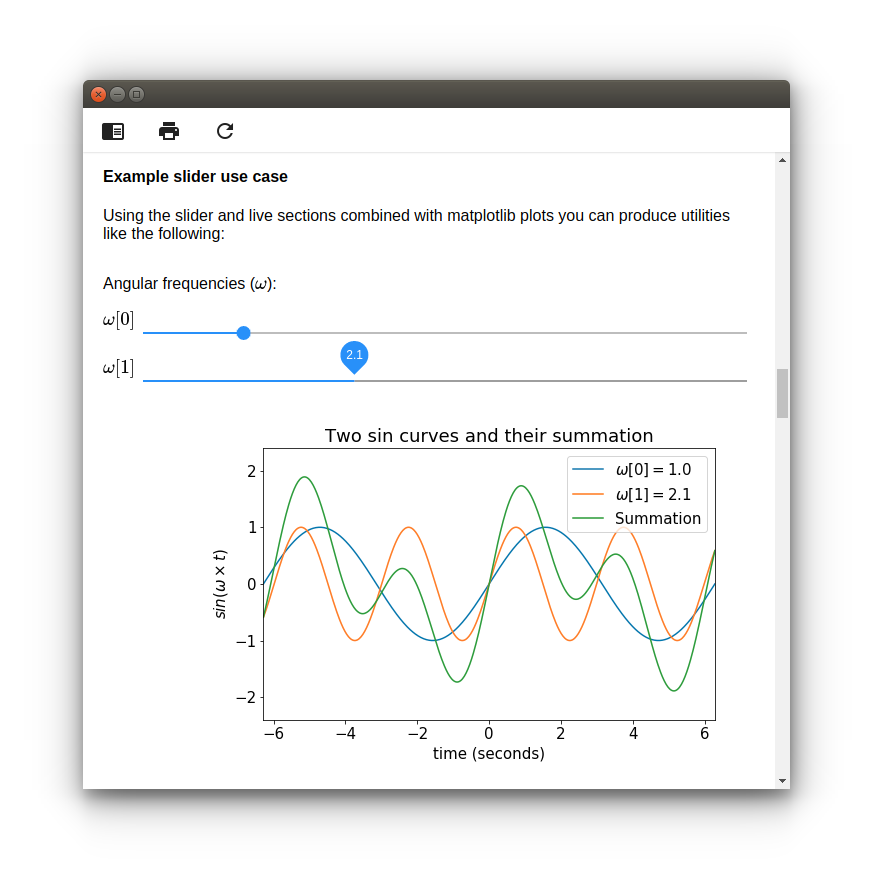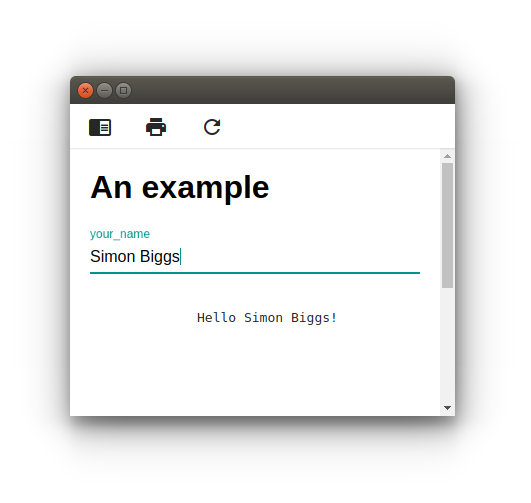SimonBiggs / Scriptedforms
Programming Languages
Projects that are alternatives of or similar to Scriptedforms
Scripted Forms 


Project Archived
This project has been archived. It was aiming to achieve similar aims to projects such as [email protected]) if you would like ScriptedForms to continue and you don't believe Voila meets your needs. If enough people reach out I shall reconsider this decision.
Overview
Making GUIs easy for everyone on your team.
The primary benefit is that front ends for Python code become easily accessible to everyone on your team. Easy to use, easy to update, easy to extend, and easy to understand.
- Quickly create live-update GUIs for Python packages using Markdown and a few custom HTML elements.
- Just write in markdown + variables / UI types
- Based on Jupyter
Development stage
This is currently in alpha stage development. Expect bugs, expect the experience to be rough around the edges at times. There are still significant changes in store for this library before it is ready to be classified as beta. However, I do encourage you to take it for a spin and journey with me, influencing what this will become.
Quick start
To use ScriptedForms you will need Python (>=3.5) on your computer. A platform independent way to install Python is to download and install the Anaconda Python distribution.
Once you have Python on your computer installing ScriptedForms is as simple as typing the following into a terminal (or command prompt):
pip install scriptedforms
Then to use it create a markdown file within your current directory called quick-start.md with any plaintext editor (such as
Visual Studio Code).
Make the contents be the following:
# An example
<section-live>
<variable-string>your_name</variable-string>
```python
print('Hello {}!'.format(your_name))
```
</section-live>
Then run the following in your terminal
scriptedforms quick-start.md
If everything worked, a Scripted Form should open within your default browser. You should be able to type your name into the form and see the code field live update with each key stroke:
Now within quick-start.md edit the markdown file by changing
# An example
to
# The form updates when I change it
and then press save. The form in the browser should then update to match what you just wrote.
Plotting and slider example
If you want to be a bit more adventurous see what happens if you add the
following to the end of the your quick-start.md file (or any other
ScriptedForm):
#### Example slider use case
Using the slider and live sections combined with matplotlib plots you can
produce utilities like the following:
<section-start onLoad>
```python
t = np.linspace(-2*np.pi, 2*np.pi, 500)
omega = np.ones(2)
```
</section-start>
<section-live>
Angular frequencies ($\omega$):
<variable-slider label="$\omega [0]$" min="0" max="6" step="0.1">omega[0]</variable-slider>
<variable-slider label="$\omega [1]$" min="0" max="6" step="0.1">omega[1]</variable-slider>
```python
plt.figure(figsize=(5*1.618,5))
oscillation = np.sin(t[:, np.newaxis] * omega[np.newaxis, :])
summation = np.sum(oscillation, axis=1)
plt.plot(t, oscillation)
plt.plot(t, summation)
plt.xlim([-2*np.pi, 2*np.pi])
plt.ylim([-2.4, 2.4])
plt.title('Two sin curves and their summation')
plt.legend([
r'$\omega [0] = {0:0.1f}$'.format(omega[0]),
r'$\omega [1] = {0:0.1f}$'.format(omega[1]),
'Summation'], loc='upper right')
plt.xlabel('time (seconds)')
plt.ylabel(r'$sin(\omega \times t)$');
```
</section-live>
This should produce what is seen in the following screenshot:

Click here to see a live version of this example on mybinder.org. This will run slower online on that server than when you are using it locally.
More features
For a markdown file that presents the majority of the features of scriptedforms see detailed.form.md. Try writing some of the contents of that file into a ScriptedForm to see how they work.
Platform/browser testing matrix
The following OS Browser combinations are explicitly tested using Sauce Labs:
Security notice
Be aware that ScriptedForms uses the Jupyter Notebook Server security model. When a user has access to the forms via the localhost web interface, should they have sufficient know how, they also have the ability to run arbitrary Python code without limitations.
By default only users on the local machine will be able to access the Jupyter Notebook Server which means if you trust a user to run code on their own machine then allowing them to use ScriptedForms will not cause issue. Only override these default settings if you understand and accept the security implications.
Furthermore do not run a scripted form unless you trust its origin. Given the reactive nature of ScriptedForms, code within the markdown template can run on form opening, as well as during usage.
[Advanced users only] Installing scriptedforms from the GitHub source
The majority of users will not need to pay attention to this section.
For those who wish to build scriptedforms from the source provided within this
repository, instead of using pypi, the javascript bundle will need to be built.
To do this you will need to
install yarn and then run the
following in the
directory containing the package.json file:
yarn
yarn build
yarn pip:install
This will install the node packages, build the javascript files and then run
pip install -e . to install the python package.
Software license agreement
Scripted Forms -- Making GUIs easy for everyone on your team.
Copyright (C) 2017 Simon Biggs
This program is free software: you can redistribute it and/or modify it under the terms of the GNU Affero General Public License as published by the Free Software Foundation, either version 3 of the License, or (at your option) any later version (the "AGPL-3.0+").
This program is distributed in the hope that it will be useful, but WITHOUT ANY WARRANTY; without even the implied warranty of MERCHANTABILITY or FITNESS FOR A PARTICULAR PURPOSE. See the GNU Affero General Public License and the additional terms for more details.
You should have received a copy of the GNU Affero General Public License along with this program. If not, see http://www.gnu.org/licenses/.
ADDITIONAL TERMS are also included as allowed by Section 7 of the GNU Affrero General Public License. These aditional terms are Sections 1, 5, 6, 7, 8, and 9 from the Apache License, Version 2.0 (the "Apache-2.0") where all references to the definition "License" are instead defined to mean the AGPL-3.0+.
You should have received a copy of the Apache-2.0 along with this program. If not, see http://www.apache.org/licenses/LICENSE-2.0.
Justification for using a copyleft license
I desire to seed a Medical Physics open source community within Australia. Medical Physicists have been repeatedly blocked from giving code to the community. There may be an opportunity for sharing however if there is an existing IP agreement that distributed code or modifications will be provided under the same license.
As such, to be able to seed a Medical Physics open source community within Australia I need to create something that helps Medical Physicists write their code and have it licensed under a copyleft license.
I hope this is that package.
For more information on why you as a Medical Physicist might want to use the AGPL-3.0+ license read the benefits of AGPL-3.0+ for Medical Physics.
Justification for the inclusion of additional terms
A significant and justifiable fear within the Medical Physics community is that should code be shared the author of the code may be liable for negligence. As such specifically addressing negligence within the additional terms is a must if this code base will become a seed to create a Medical Physics open source community in Australia.
Within Australian courts if there is any ambiguity in liability exclusion clauses they will be interpreted narrowly. If liability for negligence is not expressly excluded it may not be read as excluded within an Australian court (https://eprints.qut.edu.au/7404/1/open_source_book.pdf page 80). The same is true for clauses which seek to exclude liability for consequential loss.
The AGPL-3.0+ does not explicitly mention negligence anywhere within its license text. The Apache-2.0 does. The AGPL-3.0+ in Section 7 does define allowable additional terms. The negligence clauses within the Apache-2.0 fall under these allowable additional terms so, as such, they have been included.
There are also other desirable features of the Apache-2.0 license such as contribution, trademark, and warranty requirements. These were also included.
A note about the code sharing license requirement
If you only ever use this code internally within your company to create GUIs the only people who need to have access to the source code are those users whom you distribute the program to. Therefore you do not need to share your code outside of your company if your only users are within your company.
However there are significant benefits from sharing your code with the community. Please read the benefits of AGPL-3.0+ for Medical Physics.

